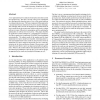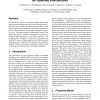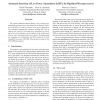9 search results - page 1 / 2 » Static power modeling of 32-bit microprocessors |
TCAD
2002
13 years 4 months ago
2002
The paper presents a novel strategy aimed at modelling instruction energy consumption of 32-bits microprocessors. Differently from former approaches, the proposed instruction-level...
ICCD
1997
IEEE
13 years 8 months ago
1997
IEEE
Asynchronous design has a potential of solving many difficulties, such as clock skew and power consumption, which synchronous counterpart suffers with current and future VLSI tech...
ASPDAC
1995
ACM
13 years 8 months ago
1995
ACM
A new approach for power analysis of microprocessorshas recently been proposed [1]. The idea is to look at the power consumption in a microprocessor from the point of view of the ...
ICCAD
2001
IEEE
14 years 1 months ago
2001
IEEE
The aim of this work is to provide an elegant and accurate static execution timing model for 32-bit microprocessor instruction sets, covering also inter–instruction effects. Suc...
DATE
2006
IEEE
13 years 10 months ago
2006
IEEE
We propose instruction-driven slicing, a new technique for annotating microprocessor descriptions at the Register Transfer Level (RTL) in order to achieve lower power dissipation....



